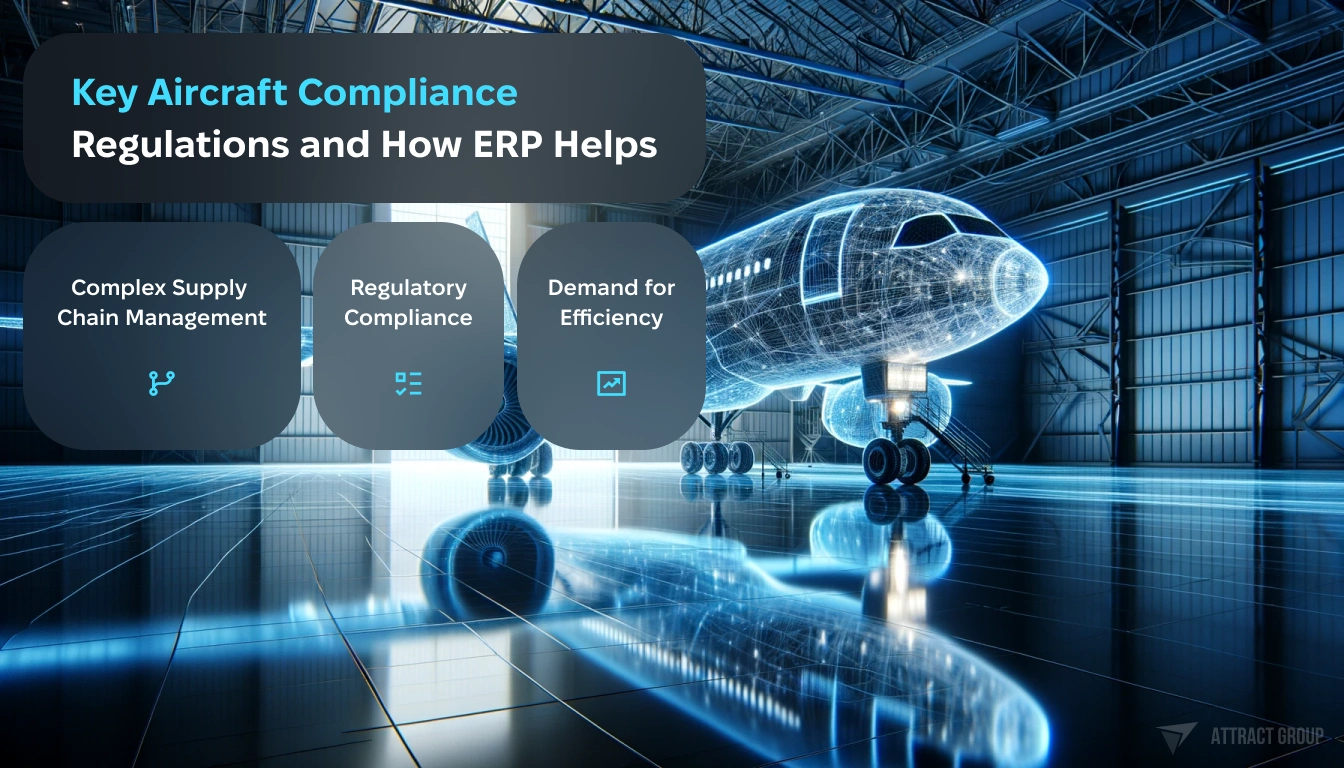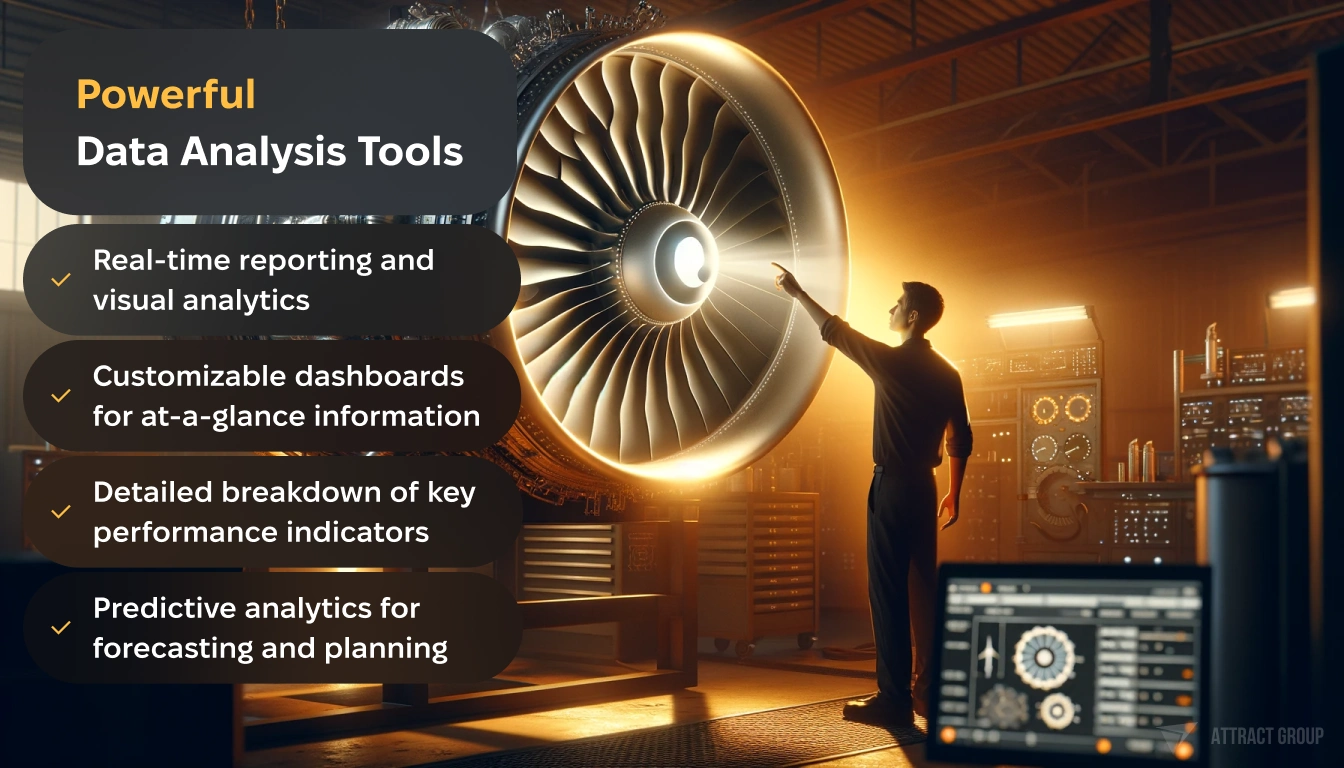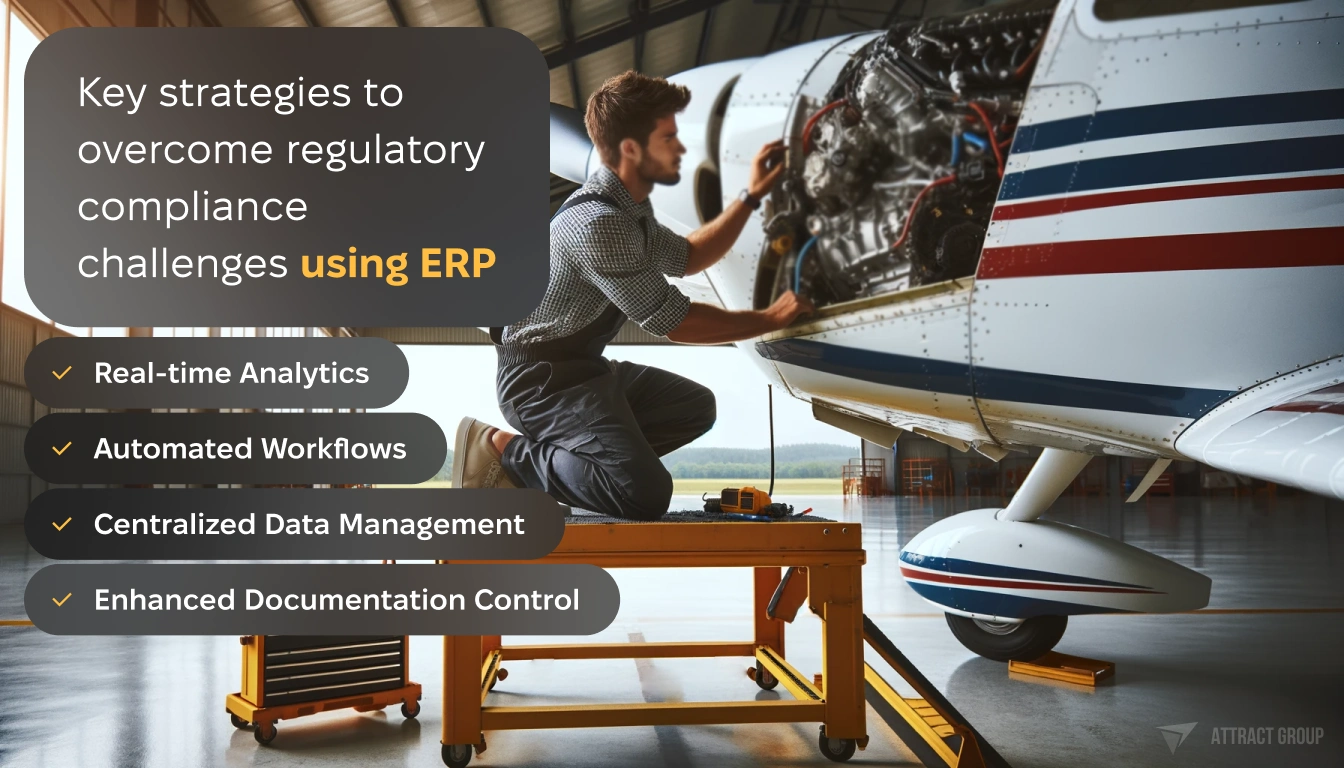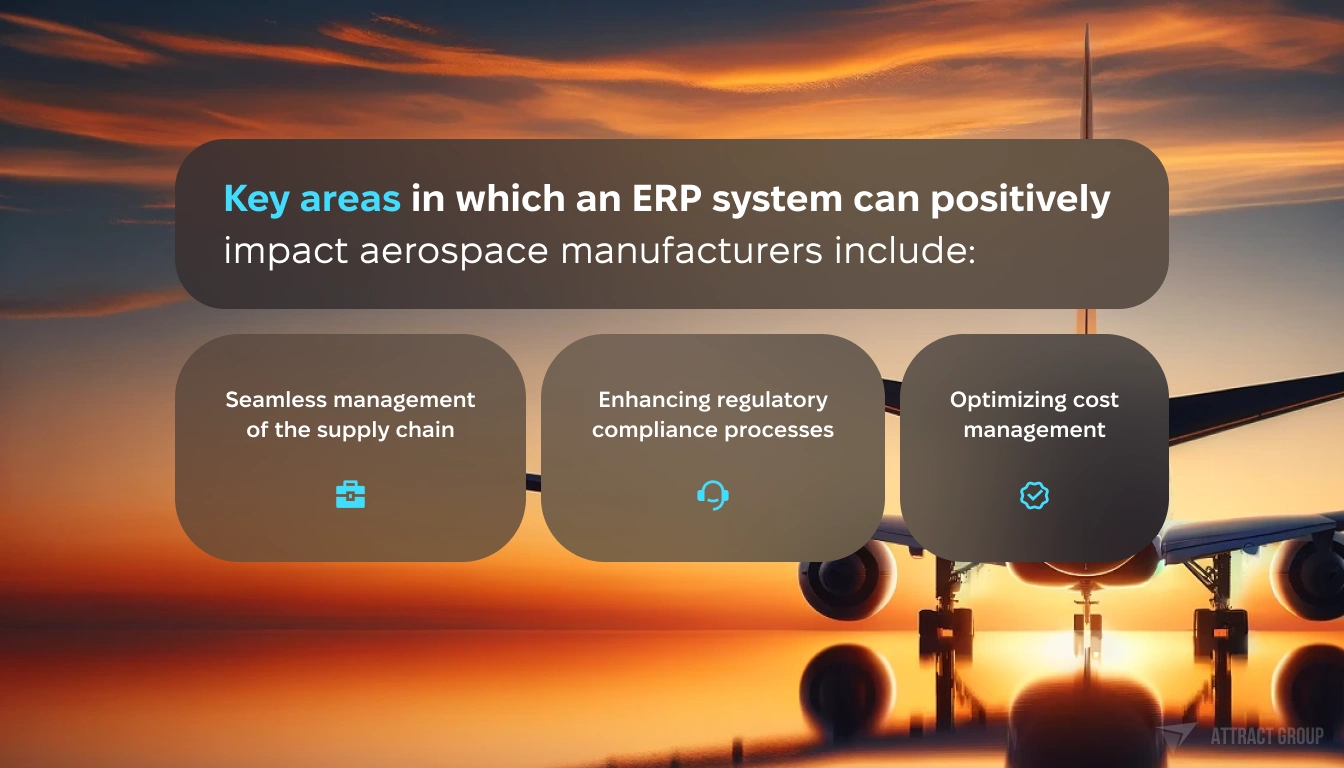Your Guide to Seamless Airplane ERP Compliance
 29 December 2023
29 December 2023? Listen to the Summary of this article in Audio
In the highly competitive and scrutinized aerospace sector, Airplane ERP Compliance is a vital aspect driving a strategic shift toward enhanced operational efficiency and innovation. Enterprise Resource Planning (ERP) systems have emerged as an invaluable tool in facilitating this change, offering a unified suite of integrated applications pivotal for managing various business processes like supply chain management, quality control, and compliance in aircraft manufacturing. By fostering a more agile and competitive business model, ERP systems not only optimize workflows but also provide essential capabilities for maintaining regulatory compliance and ensuring aerospace production efficiency.
Key Takeaways
- Airplane ERP Compliance boosts the strategic growth and innovation in the aerospace industry.
- ERP systems enable seamless management of supply chain, quality, and compliance in aircraft manufacturing.
- Aviation ERP software allows companies to maintain regulatory compliance and optimize operational efficiency.
- Industry-specific ERP systems address unique challenges faced by the aerospace sector.
- Customized and scalable ERP solutions ensure long-term success and growth in the ever-evolving aviation industry.
Understanding Airplane ERP Compliance
Airplane ERP Compliance is a critical aspect of aircraft manufacturing, involving the integration of ERP systems to ensure that stringent regulatory standards are met. The complex nature of aircraft manufacturing comprises numerous intricate parts, high safety standards, and a vast network of suppliers. To manage this level of complexity, an ERP system that effectively ties together different operational segments is vital.

An ERP system in aerospace manufacturing enables the management of various processes under one cohesive platform, ensuring compliance and enhanced productivity. By facilitating adherence to various business activities and regulatory demands, operational transformation can be achieved, resulting in a streamlined ecosystem of processes and an efficient workflow within the aerospace industry.
“An ERP system fosters a seamless experience in managing the complexities of aircraft manufacturing, creating a unified approach in maintaining regulatory compliance and productivity.”
Key aspects of aircraft compliance regulations that ERP systems help address include:
- Integration of multiple business processes for more efficient management
- Real-time monitoring and reporting of manufacturing progress
- Quality control management and adherence to safety standards
- Inventory optimization and management through automation
- Seamless coordination with a vast network of suppliers
Embarking on an ERP implementation project is a crucial step towards achieving operational transformation in the aerospace industry. Through the integration of a well-designed ERP system, aircraft manufacturers can unlock more efficient and agile workflows, which help maintain compliance with ever-changing regulatory standards.
The Role of Aviation ERP Software in Compliance
Aviation ERP software plays a critical role in managing and facilitating compliance in the complex landscape of aerospace manufacturing. By implementing integrated ERP systems, businesses can streamline their operations, improve efficiency, and ensure adherence to stringent industry regulations. This helps aircraft manufacturers maintain a competitive edge while promoting sustainability and growth in the market.
Streamlining Complex Processes
Efficient scheduling, resource allocation, and workflow management are essential aspects of the aviation industry, needing precision and agility to achieve optimal performance. Aviation ERP software integrates various business activities into a single system, resulting in simplified and streamlined aerospace manufacturing processes. This, in turn, leads to increased production efficiency, reduced time-to-market, and enhanced aerospace operational efficiency, giving companies a competitive advantage.

“Streamlined operations in aerospace manufacturing not only improve efficiency but also serve as a foundation for adhering to industry regulations and ensuring overall compliance.”
Facilitating Regulatory Adherence
One of the primary challenges in the aviation industry is maintaining compliance with ever-changing aerospace regulatory requirements. Aviation ERP for compliance offers a solution by providing tools and features specifically designed to track these requirements, maintain necessary documentation, and ensure that all manufacturing processes meet industry standards.
Integrated ERP systems offer the following key benefits for maintaining compliance in the aviation industry:
- Effective tracking and management of compliance requirements
- Automated documentation and record-keeping
- Real-time monitoring and reporting of compliance status
- Improved visibility and control over manufacturing processes
| Challenges | Aviation ERP Solutions |
|---|---|
| Complex aerospace regulatory landscape | Structured and organized methods to comply with safety and quality regulations |
| Potential risks associated with non-compliance | Proactive monitoring and reporting tools to mitigate risks effectively |
| Managing intricate processes and documentation | Automated tools for efficient data management, tracking, and reporting |
Ultimately, aviation ERP software serves as a powerful tool to help aircraft manufacturers navigate the complex world of aerospace regulatory compliance, significantly reducing the risks associated with non-compliance and promoting operational excellence.
Key Aircraft Compliance Regulations and How ERP Helps
Aircraft ERP systems play a crucial role in adhering to the aerospace industry’s stringent regulatory standards. These regulations encompass various aspects of airplane manufacturing, including supply chain management, quality control, and overall operational efficiency. To ensure airplane ERP compliance, manufacturers need to navigate a complex regulatory landscape and align their processes according to aerospace industry standards. ERP regulatory compliance is achieved through various robust features found within ERP systems, which are detailed below:
- Complex Supply Chain Management: Aircraft manufacturing involves a vast network of suppliers, making it crucial to have an efficient supply chain management system in place. ERP systems simplify this process by integrating different operational segments, allowing for better communication, traceability, and enhanced visibility across the entire supply chain.
- Regulatory Compliance: Ensuring regulatory compliance is imperative for aircraft manufacturers. With an ERP system in place, manufacturers can manage complex processes, handle intricate parts, and maintain safety standards with ease. ERP systems provide tools for tracking compliance requirements, maintaining necessary documentation, and ensuring that all manufacturing processes meet industry standards.
- Demand for Efficiency: In the fast-paced aerospace sector, manufacturers are constantly faced with the need for optimal efficiency. ERP systems offer features like real-time analytics, automated workflows, and resource allocation that enable streamlined operations, driving operational excellence and keeping up with industry demands.

Apart from ensuring airplane ERP compliance, ERP systems also play a key role in reducing errors, simplifying documentation, and maintaining the quality of components. These robust features not only enable manufacturers to uphold compliance standards but also instill a proactive approach toward managing industry-specific regulations. Let’s consider some of these features and their impact on aerospace compliance:
| ERP Feature | Compliance Impact |
|---|---|
| Real-time analytics | Empowers manufacturers to make informed decisions based on metrics, driving better compliance management and streamlining processes. |
| Automated workflows | Improves process efficiency by automatically executing repetitive tasks, reducing the risk of errors associated with manual operations, and assisting in adhering to regulatory requirements. |
| Quality control tools | Ensures that all components and processes meet required specifications, safeguarding compliance with safety regulations and maintaining high-quality standards. |
Aircraft ERP systems play an invaluable role in maintaining airplane ERP compliance. These systems empower manufacturers to manage the complex process of adhering to aerospace industry standards and keep them nimble in the face of ever-changing regulatory landscapes. By leveraging ERP systems, aircraft manufacturers can ensure successful ERP regulatory compliance, thereby securing their position as industry leaders.
Why Aerospace Needs Industry-Specific ERP Systems
The aerospace industry faces unique challenges, such as long product life cycles, complex supply chains, and strict regulatory compliance needs. These factors necessitate the adoption of industry-specific ERP for airplanes to ensure optimized operations and greater control over manufacturing processes, quality, and supply chain logistics. Traditional ERP solutions might not adequately address aerospace-specific ERP requirements, making customization in aircraft manufacturing essential for meeting the precise demands of the sector.
One of the major ERP strategic benefits in aviation is the ability to tailor the system according to the organization’s unique needs, a factor which cannot be achieved through generic ERP solutions. Customized ERP systems offer a range of advantages, including:
- Efficient resource allocation
- Improved decision-making capabilities
- Streamlined processes across the organization
- Better control over compliance requirements
Further, ERP customization in aircraft manufacturing allows aerospace manufacturers to adapt and scale their ERP systems in line with changing industry demands, ensuring that their business remains agile and responsive in a competitive market.
Industry-specific ERP systems are not just a technology upgrade for aerospace manufacturers; they are an essential strategic tool that aligns business processes with industry-specific regulations and competitive market demands.
| Aerospace Challenges | ERP Customization Benefits |
|---|---|
| Long product life cycles | Better lifecycle management and long-term planning |
| Complex supply chains | Enhanced supply chain visibility and control |
| Strict regulatory compliance | Tools and features to effectively manage and track compliance |
| Industry-specific requirements | Tailored solutions for optimized aerospace operations |
The aerospace industry’s unique challenges and requirements call for industry-specific ERP systems that can be customized and scaled to meet the precise demands of the sector. By implementing such systems, manufacturers can achieve higher operational efficiency, maintain compliance, and stay competitive in the dynamic aviation market.

The Importance of Compliance Management Software in Aviation
Compliance management software is a critical component in the aviation industry, facilitating streamlined documentation and efficient data analysis essential for adhering to regulatory standards. ERP systems simplify the storage and management of data, enabling quicker, more coherent data analysis and reporting processes. This support empowers aviation companies to remain compliant, make informed decisions, and effectively manage resources across various departments such as maintenance operations, finance, and HR.
Effective Documentation and Data Analysis
Effective documentation and data analysis are fundamental for meeting regulatory standards in aviation. Compliance management software helps aviation companies maintain a well-organized documentation process, with ERP systems offering features like:
- Centralized document storage
- Quick search and retrieval capabilities
- Real-time updates and revision tracking
- Automated workflows for document approvals and distribution
These features ensure that necessary paperwork is easily accessible, up-to-date, and compliant with industry requirements.
By leveraging the advanced features of ERP systems, aviation companies can streamline their documentation processes, allowing them to focus on enhanced operational efficiency and business growth.
Data analysis is another crucial aspect of aviation compliance. ERP systems provide a comprehensive platform for analyzing a multitude of data points, such as quality control, maintenance performance, and financial information. These insights allow companies to detect potential compliance risks, assess operational efficiency, and make data-driven decisions in a rapidly evolving industry.
ERP systems provide aviation businesses with powerful data analysis tools such as:
- Real-time reporting and visual analytics
- Customizable dashboards for at-a-glance information
- Detailed breakdown of key performance indicators
- Predictive analytics for forecasting and planning
With these robust capabilities, aviation companies can maintain a competitive edge by ensuring compliance, optimizing resource allocation, and adapting to ever-changing regulatory landscapes.
| ERP Data Analysis Features | Benefits |
|---|---|
| Real-time reporting | Immediate access to essential information for informed decision-making |
| Visual analytics | Easy-to-understand representation of crucial data for better insights |
| Customizable dashboards | Tailored views of the most relevant information for specific operations and departments |
| Predictive analytics | Anticipate future trends and challenges to proactively implement strategic decisions |
Compliance management software in aviation plays an indispensable role in facilitating effective documentation and data analysis, ultimately contributing to streamlined operations, enhanced resource management, and optimal regulatory compliance. By harnessing the power of ERP systems, aviation companies can maintain their competitiveness and growth in an increasingly dynamic and complex industry landscape.

Strategic Benefits of Aircraft Maintenance ERP Solutions
The strategic advantages that aircraft maintenance ERP solutions provide are vital for a more efficient and cost-effective aerospace production environment. By implementing ERP systems, companies can experience multiple benefits, such as more streamlined workflows, improved decision-making through accurate data, and optimized resource management, resulting in reduced costs.
Let’s explore the key strategic benefits offered by aircraft maintenance ERP and how they enhance aerospace production workflows:
- Enhanced operational efficiency
- Improved data accuracy for better decision-making
- Reduced costs through optimized resource management
ERP systems boost operational efficiency by centralizing data management and streamlining the processes crucial to the aerospace industry, such as supply chain coordination and production planning.
These systems also improve data accuracy through an integrated and easily accessible platform, resulting in better decision-making processes across various departments of an aerospace company.

| Strategic Advantages | Benefits |
|---|---|
| Enhanced Operational Efficiency | Centralized data management and streamlined processes for supply chain coordination and production planning. |
| Improved Decision-Making | Accurate data collection, analysis, and reporting across various departments, which allows for better decisions based on real-time information. |
| Reduced Costs | Optimized resource management that lowers operational costs and contributes to an increased return on investment. |
Investing in aircraft maintenance ERP solutions effectively equips aerospace manufacturers with the tools needed to streamline their workflows, make informed decisions based on accurate data, and optimize resource management, ultimately resulting in a more competitive and agile organization.
Custom ERP Development for Enhanced Aviation Compliance
Custom ERP development is pivotal for enhanced aviation compliance, offering the ability to tailor systems to the precise needs of airline operations. Personalized ERP solutions provide the scalability and flexibility required to manage the complexities of the aviation industry, including customizing features for unique manufacturing processes, supply chain management practices, and adherence to aviation-specific regulatory compliances.
Personalization for Airline Operations
Custom ERP development allows aerospace companies to create tailored ERP systems that align with the intricate requirements of airline operations. These bespoke solutions offer a plethora of benefits, such as:
- Streamlined workflows tailored to the specific operations of each airline.
- Increased efficiency by integrating all relevant processes into a single interface.
- Automated updates ensuring compliance with the ever-changing regulatory landscape.
- Enhanced decision-making capabilities through personalized analytics and reporting.
Scalability for Growing Aviation Demands
As the aviation industry continues to expand, companies need scalable ERP for aviation that can adapt to their growing requirements. A custom-developed ERP system offers:
- Flexibility that enables seamless adjustments to accommodate a company’s expansion.
- Efficient management of increasing data volumes, ensuring sustained performance and compliance even as processes and operations become more complex.
- Growth-oriented ERP solutions equipped with features designed to drive organizational progress and development.
“By investing in custom ERP development for the aviation industry, companies can ensure that their processes, analytics, and regulatory compliance measures evolve as they grow, allowing for sustained success and alignment with market demands.”
In summary, custom ERP development aviation offers aerospace companies the opportunity to harness the power of personalized ERP solutions and scalable systems. By investing in tailored solutions, airlines can maintain optimal efficiency and regulatory compliance while continually growing and adapting to the ever-changing aviation landscape.

Navigating Aviation Regulatory Compliance Challenges with ERP
Implementing strategies that address the safety, reliability, availability, and budgetary constraints of aircraft operations is paramount for navigating aviation regulatory compliance challenges with aviation regulatory compliance ERP. By providing comprehensive visibility and control over all aspects of aviation compliance, including maintenance, inventory, and fleet management, ERP systems enable businesses to overcome regulatory hurdles.
ERP systems facilitate this process by integrating crucial functions such as reporting, analytics, resource management, and documentation control, allowing businesses to address navigating compliance challenges aviation ERP. These systems empower companies to develop ERP compliance strategies aircraft by providing real-time insight into essential regulatory requirements and devising effective methods to comply with them.
Our team can assess your operations and provide strategic advice on implementing an ERP system tailored to your regulatory needs
“An ERP system can make all the difference when it comes to successfully navigating the complexities of aviation regulatory compliance.”
The following key strategies can be employed by businesses to overcome regulatory compliance challenges in the aviation industry using ERP:
- Real-time Analytics: Using ERP systems to gather and analyze data in real time allows organizations to detect compliance issues early on and initiate corrective actions proactively.
- Automated Workflows: ERP systems streamline processes through automated workflows, ensuring that compliance tasks are completed accurately and consistently across the organization.
- Centralized Data Management: A centralized data repository helps maintain an organized collection of compliance-related information, simplifying audits and reducing the risk of errors or miscommunications.
- Enhanced Documentation Control: By providing tools for managing documentation, ERP systems can help organizations track and maintain regulatory records efficiently.

ERP systems are critical tools in helping businesses navigate aviation regulatory compliance challenges. Through the integration of key functions like real-time analytics, automated workflows, and centralized data management, ERP systems enable organizations to develop effective compliance strategies and steer clear of potential noncompliance issues.
Best Practices for ERP Implementation in the Aviation Industry
Implementing an ERP system in the aviation industry is a complex process that requires careful planning and execution. To ensure the successful integration of an ERP solution with business operations, organizations should adhere to a set of best practices that encompass assessment, planning, customization, and system integration. These practices are critical in addressing the unique demands of aircraft manufacturing while maintaining regulatory compliance and achieving operational efficiency.
Assessment & Planning
Undoubtedly, the first stage in a successful ERP implementation is the assessment and planning phase. During this stage, organizations must:
- Evaluate their specific business needs and requirements
- Identify the key features and functionalities that support these requirements
- Select an appropriate ERP system that aligns with the operational and industry-specific needs
- Develop a comprehensive and realistic implementation timeline
Furthermore, organizations must consider various components, such as budget, system capacity, and vendor support, to ensure a seamless ERP implementation process. The strategic assessment and planning in the aviation industry can help companies maneuver through the complexity of ERP system selection and integration. This approach can align operational requirements with ERP capabilities and functionalities, allowing businesses to fully leverage the potential of the ERP system.
System Customization and Integration
Customization and system integration are essential for a successful ERP implementation in the aviation industry. Tailoring the ERP system to fit the unique demands of aircraft manufacturing and harmonizing it with pre-existing processes is essential. Key steps include:
- Configuring the ERP system to address the specific needs of the aviation industry, including supply chain management, maintenance, and regulatory compliance
- Integrating the ERP system with existing business processes and software applications to ensure a seamless transition
- Developing and providing adequate user training to ensure staff proficiency with the new system
- Conducting thorough system testing to validate that all components function as intended within the operational workflow
“Adapting the ERP system to fit the unique demands of aircraft manufacturing and harmonizing it with pre-existing processes is crucial for a successful implementation.”
Implementing an ERP system in the aviation industry requires careful assessment, planning, customization, and integration. By adhering to these best practices, aviation companies can optimize their ERP implementation process and ensure a smooth transition that ultimately drives operational efficiency, regulatory compliance, and business growth.
We specialize in building customized ERP solutions for aircraft manufacturers. Our aviation experts can design a system aligned to your specific workflows and processes
Impact of ERP on Airline Efficiency and Compliance
ERP implementation case studies in the aviation industry reveal the significant impact these systems have on airline efficiency and compliance. One such example showcases how an aerospace manufacturer witnessed a 20% increase in production efficiency after ERP system integration. This feat reflects the various ways ERP systems enhance operational processes for aerospace companies.
Key areas in which an ERP system can positively impact aerospace manufacturers include:
- Seamless management of the supply chain
- Enhancing regulatory compliance processes
- Optimizing cost management
Table 1 below illustrates the tangible benefits that ERP solutions bring to the aviation industry in terms of efficiency and compliance.
| Benefits of ERP | Impact on Aviation Industry |
|---|---|
| Supply Chain Management | Effective organization and coordination of suppliers, logistics, and inventory reduce lead times. |
| Regulatory Compliance | Automated tracking and reporting of compliance-related information streamline adherence to aviation industry standards. |
| Cost Management | Improved resource allocation and data-driven decision-making lead to leaner operations and lower expenses. |
These case studies serve to illustrate the transformative power of ERP solutions when implemented within the aerospace industry. By optimizing various aspects of operations, ERP systems facilitate cost-effective growth and a more robust approach to aviation compliance.

How to Select the Right ERP Solutions for Airlines
Selecting the right ERP solution for airlines is crucial to ensure the smooth integration of essential software for aircraft manufacturing operations. Given that a tailored ERP system can facilitate significant improvements in efficiency, productivity, and regulatory compliance, it is important to make an informed decision when choosing ERP systems for aviation businesses. The following key factors should be considered when making this important decision:
- Evaluating unique operational needs
- Gathering input from all departments
- Assessing the provider’s industry experience
- Ensuring the vendor offers adaptable systems
- Checking for comprehensive post-implementation support
To begin with, airlines should evaluate their unique operational requirements, considering aspects such as maintenance and inventory management, human resource management, financial accounting, and customer service. This facilitates informed decision-making when selecting an ERP system that aligns with a company’s unique needs.
It is essential to gather input from all departments before choosing an ERP system to ensure a seamless and effective implementation process. By involving decision-makers from across the organization, a comprehensive understanding of the airline’s requirements can be developed.
Next, assess the provider’s industry experience to ensure they have a track record of implementing successful ERP solutions in the aviation industry. A vendor with a proven history of working with airlines is likely to understand the unique challenges faced by the industry, enhancing their ability to deliver a solution that meets specific requirements.
| Evaluation Criteria | Relevance to Airlines |
|---|---|
| Operational needs | ERP solution must align with the company’s unique maintenance, inventory, HR, and financial processes |
| Departmental input | Improves buy-in and ensures a comprehensive understanding of business requirements |
| Industry experience | Indicates the provider’s ability to deliver an ERP solution tailored to the aviation sector |
| Adaptable systems | Ensures the ERP system can change and grow with the company’s evolving needs |
| Post-implementation support | Provides assurance of ongoing assistance and troubleshooting to maximize the ERP system’s utility |
Finally, choose a vendor that offers adaptable systems and comprehensive post-implementation support. Ensuring the ERP system remains relevant as the company evolves and grows is crucial to the long-term success of the implementation. Comprehensive support after implementation can assist with troubleshooting and addressing any issues that may arise as the ERP system is integrated into the company’s workflow.
We not only offer adaptable aviation ERP systems but provide full-spectrum implementation and post-go-live support.
Conclusion
In conclusion, the adoption of effective ERP systems is pivotal for achieving modern aerospace advancements and seamless airplane ERP compliance. These systems are instrumental in transforming the aviation industry by enhancing efficiency, promoting strategic decision-making, and delivering successful implementation.
Reaping the full benefits of ERP systems in the aviation industry necessitates a tailored approach. Solutions must address the unique needs of the sector while equipping companies with the ability to navigate the complexities of industry-specific regulations and juggle vast operational and compliance demands. By ensuring an adaptable and industry-focused approach, businesses can prepare themselves to face future challenges deftly.

Ultimately, ERP systems in the aerospace industry are more than mere digital upgrades. They are strategic tools that integrate various business processes, paving the way for optimal industry compliance and continued improvements in the manufacturing sector. It is through these comprehensive and intelligent ERP solutions that aircraft production becomes an increasingly agile, resilient, and competitive industry, allowing aviation stakeholders to thrive in the face of ongoing market challenges.
FAQ
What is Airplane ERP Compliance?
Airplane ERP Compliance involves ensuring that aircraft manufacturers meet stringent regulatory standards through integrated systems that manage complex processes. ERP systems help maintain compliance and provide a cohesive platform for enhanced productivity, facilitating adherence to various business activities and regulatory demands.
How does aviation ERP software support regulatory adherence?
Aviation ERP software provides tools for tracking compliance requirements, maintaining necessary documentation, and ensuring that all manufacturing processes meet industry standards. ERP systems help aircraft manufacturers navigate complex regulatory landscapes by offering structured and organized methods to comply with safety and quality regulations, reducing the risks associated with non-compliance.
Why is industry-specific ERP important for the aerospace industry?
The aerospace industry requires industry-specific ERP systems due to the unique challenges it faces, such as long product life cycles, complex supply chains, and strict regulatory compliance needs. Specificity in ERP solutions allows for greater control over manufacturing processes, quality, and supply chain logistics, ensuring that aerospace manufacturers can meet the precise demands of the sector.
What role does compliance management software play in the aviation industry?
Compliance management software is critical in aviation as it ensures effective documentation and data analysis, which are paramount to meeting regulatory standards. ERP systems aid in the efficient storage and management of data, enabling quicker and more coherent data analysis and reporting. This supports aviation companies in staying compliant, making informed decisions, and effectively managing resources across various departments.
What are the benefits of custom ERP development for the aviation industry?
Custom ERP development is pivotal for enhanced aviation compliance, offering the ability to tailor systems to the precise needs of airline operations. Personalized ERP solutions provide the scalability and flexibility required to manage the complexities of the aviation industry, including customizing features for unique manufacturing processes, supply chain management practices, and adherence to aviation-specific regulatory compliances.
What are the best practices for ERP implementation in the aviation industry?
Best practices for ERP implementation in the aviation industry start with a thorough assessment and planning phase. Establishing a comprehensive plan includes understanding the specific needs of the business, selecting an appropriate ERP system, and determining the extent of necessary customization and configuration. System customization and integration are critical to a successful ERP implementation, including training and testing to ensure staff proficiency and proper function within the operational workflow.
How do I select the right ERP solution for my airline?
Selecting the right ERP solutions for airlines necessitates careful consideration of the company’s unique operational needs, including but not limited to its maintenance and inventory requirements, human resource management, financial accounting, and customer service. The process involves gathering input from all departments, assessing the provider’s industry experience, and ensuring the vendor offers adaptable systems with comprehensive post-implementation support.









